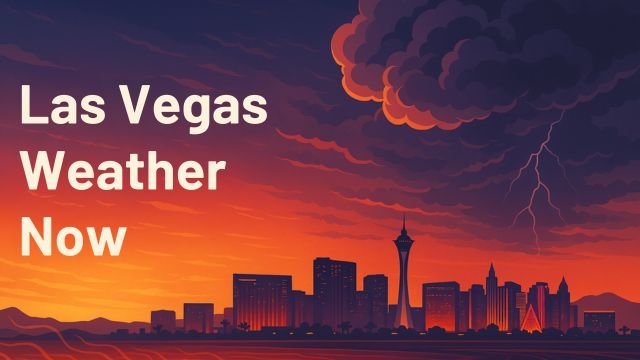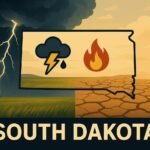Las Vegas weather is performing its signature trick again, dry desert heat rising like a curtain from the asphalt, while an unexpected twist of monsoon moisture slides in quietly from the east. If you’ve stepped outside anytime after sunset and still felt like you were baking, you’re not imagining things. This heat holds on, and tonight is shaping up to be one of those lingering desert evenings where even the shadows feel warm.
Let’s break down what’s happening in real time, why it matters, and what’s coming next for locals, travelers, and anyone thinking of braving the Strip under a sky that might suddenly erupt in thunder or stay dry as dust.
Desert heat with a stormy guest appearance
It’s late evening and the official temperature near Harry Reid International Airport is still floating around 95 °F. Strip-level sensors are showing a few spots closer to 100 °F even as the sun dips behind Red Rock. That’s classic Las Vegas weather—where the concrete, the buildings, and even the decorative rocks radiate back heat long after the sun disappears. The humidity, as always, plays the background role here, low enough to lull you into forgetting you’re sweating until your water bottle’s empty. Current relative humidity readings hover under 25%, which sounds good until you remember that means you dehydrate faster without noticing it.
But here’s where things start to shift. There’s a subtle influx of moisture riding in from Arizona, part of an early-season monsoon flow. Forecasts are showing a 20 to 30 percent chance for pop-up thunderstorms tomorrow afternoon, particularly from 3 PM to 7 PM. Nothing widespread, but in Las Vegas, even isolated storms are dramatic. Thunder echoing off the mountains, walls of dust racing across open lots, and lightning spiderwebbing above the casinos—all while some neighborhoods stay bone-dry.
This patch of moisture won’t last long. By Thursday, high pressure returns with dry skies and another round of triple-digit highs. Expect temperatures around 102 °F on Wednesday and just a degree or two cooler Thursday. It’s the kind of pattern that tricks you: a brief breeze, a glimpse of clouds, maybe even a rain-smelling wind—and then, right back to relentless sun and mirror-like heat off the pavement.
What it means for your week in Las Vegas
Tonight’s lows? Think low 80s if you’re lucky, especially if you’re east of I-15. That’s barely enough to cool off the sidewalks, and certainly not enough for solid rest if you’re in an unairconditioned space. Tomorrow, things rise fast again. Around 10 AM, temperatures surge past 90 °F. By early afternoon, we’re staring down 101 °F, possibly 104 °F in the eastern neighborhoods. If a storm does fire up, it’ll likely be over the southeast valley, with strong gusts and a short-lived show of rain or dust. For most folks, it might just be a dramatic sky and a wind-blasted patio.
Air quality is mostly holding steady, but the ozone index is something to watch. It’s been sitting in the upper moderate range this week, which means sensitive groups like children, older adults, and anyone with breathing issues should avoid the midafternoon outdoor exposure. The UV index, too, is hitting extreme levels at solar noon. That’s SPF-30-and-above territory, and reapplying every two hours isn’t overkill—it’s necessary.
The broader seven-day outlook keeps the heat dialed up. Thursday through Sunday continues the hot trend, with highs between 103 °F and 107 °F. Independence Day looks dry, bright, and breezy—perfect for fireworks visibility, not so perfect for anyone stuck grilling in full sun. Early next week, some models hint at another trickle of monsoon moisture, but it’s far too early to promise anything real from that. In the desert, forecasts more than three days out are more suggestion than certainty.
Safety first, shade second
For residents, the message is familiar but always worth repeating. Las Vegas weather doesn’t just flirt with danger in summer—it settles into it. Pavement temperatures are often 15–20 degrees higher than the air, meaning pet paws and bare skin can get burned in seconds. Cars turn into ovens in minutes. Even quick errands demand planning: water, sun protection, and checking that your AC isn’t on the verge of quitting.
Visitors should note: the Strip is deceptive. Casino distances look walkable on a map, but under the desert sun, that 0.4-mile trek from New York-New York to Bellagio feels like a marathon. Plan outdoor time for early mornings or after sunset. Use those giant air-conditioned interiors to your advantage. Hydration isn’t just a poolside thing—it’s a survival tool out here.
If storms do pop up, stay alert. Flash floods happen fast in Las Vegas, especially in washes and road dips that seem harmless until they’re filled with brown, surging runoff. Don’t try to “just drive through it.” And don’t assume the first few raindrops mean relief. These desert storms can evaporate before they hit the ground, leaving behind dangerous winds and lightning without a drop of cooling rain.
The big picture
Zooming out, this week’s Las Vegas weather shows signs of what climatologists have been warning about for years. Rising average temperatures. Shorter, more intense storm bursts. Higher nighttime lows. Less recovery time between extreme heat days. UNLV data even confirms Las Vegas is now the second fastest-warming city in the U.S. Since 1970, average temperatures have jumped nearly 6 degrees Fahrenheit, pushing this desert city into new territory when it comes to managing heat stress, infrastructure wear, and public health.
That doesn’t mean every day is deadly. It means every summer week demands more awareness. Whether you’re a lifelong local or a weekend visitor, Las Vegas weather now asks you to pay attention—to your body, to your surroundings, to the sky. Because in this city, the heat isn’t just a backdrop. It’s a force.
So what’s next? Likely, more heat. A short-lived flirtation with monsoon action. A reminder that summer in Las Vegas is never just hot—it’s strategic. It’s about timing your walks, layering your sunscreen, packing your water, and knowing when to rest, when to watch the horizon, and when to head for shade.
Because the desert may be predictable in its extremes, but it always finds a way to surprise.


